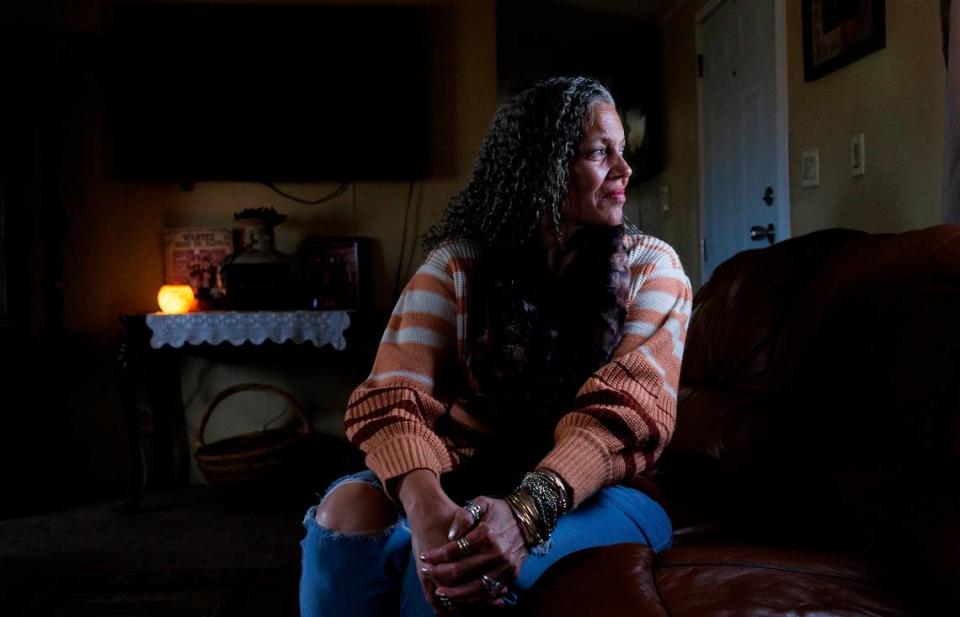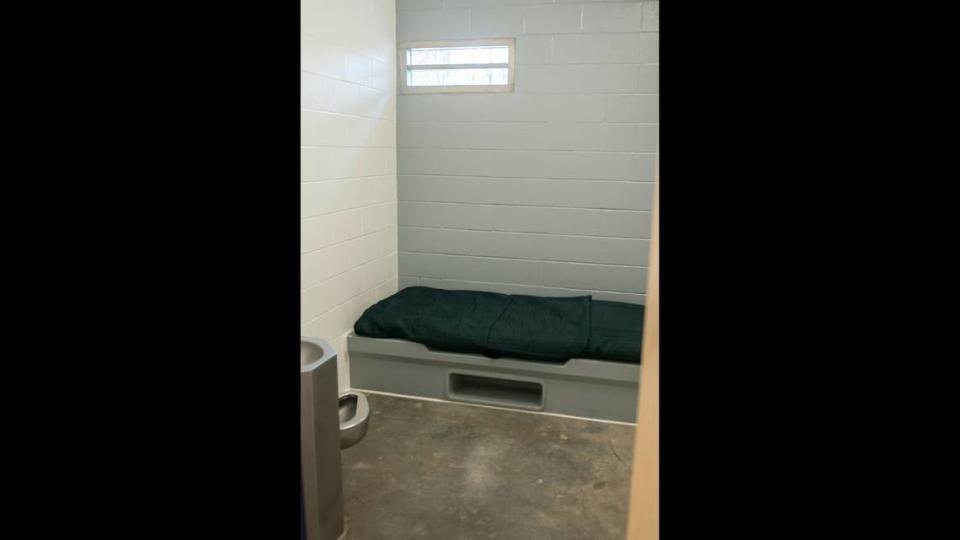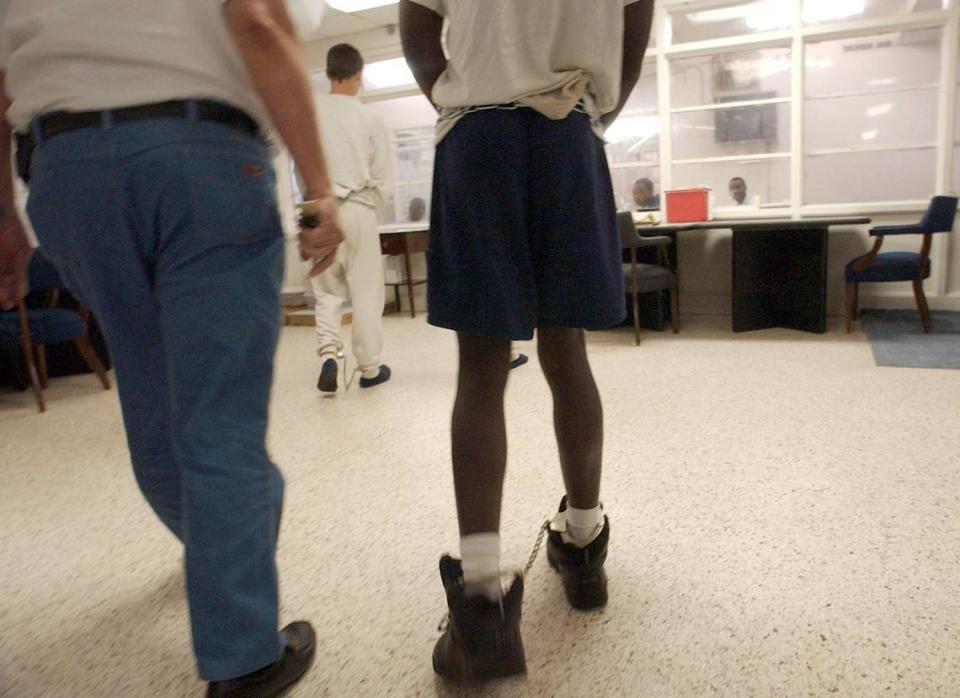Black worms, expired milk, no class: NC teen details state lock up amid staffing crisis
Sitting in his home, across the kitchen table from his mother, a 17-year-old mapped out the room where he lived locked up for a month and a half.
There was a small window with bars near the ceiling, he said, as he sketched an outline on a yellow notepad. He used to stand on his bed and look out the window, pretending he was throwing a three-pointer in the outside basketball hoop.
“The only time I went outside was when I went to court,” he said.
In the corner of the roughly 7-by-9 foot room there was also a metal sink and a toilet, where he said he once saw long black worms swimming before going to the bathroom.
A beige, steel locked door separated him from a hallway he could not see at C.A. Dillon Regional Juvenile Detention Center, one of North Carolina’s 10 sites where the state confines minors accused of crimes and others awaiting transfer to another program or facility.
“We couldn’t look out the hallway because they had a black thing over the door,” said the teenager, who was released from Dillon on Dec. 19.
The state juvenile division normally aims for youth in detention to spend most of their days outside of their rooms learning, exercising and participating in therapy, state officials say.
But the teen is one of hundreds in North Carolina who state officials put in what attorneys call solitary confinement-like conditions in recent years due to staffing shortages and other challenges.
Lawyers this week asked a state court to forbid the practice, which experts say is harmful to minors.

A school disturbance
The teen who spent most of his time at Dillon locked in a small narrow room has a history of not controlling his anger in adverse situations, his mother said, but he’s never been charged with hurting anyone.
His mother Niesha Williams traces her son’s anger to day care workers who beat his bottom so hard it was covered in purple bruises, Williams said. One person pleaded guilty to misdemeanor child abuse and another misdemeanor aid and abet, according to court documents.
As a kindergartener, he would run away from school, Williams said. He was diagnosed with attention deficit hyperactivity disorder and post-traumatic stress disorder then. More recently he was diagnosed with oppositional defiant disorder, his family said.
The News & Observer is not naming him because he is a minor and juvenile court charges are not public under state law.
A judge ordered that the teen be sent to residential detention due to a series of events at his high school in the spring of 2023. After concluding someone had stolen $31 from his backpack, the teenager banged on a classroom door window so hard he broke it.
After the school principal told him, his mother and stepfather that the action would bar him from trying out for the school’s baseball team or trying to get his money back, the teen threatened to blow up his school.
A judge ordered the teen to go to a boy’s residential facility in Boomer in Wilkes County, but he was sent home two months later after he struggled in the program and wasn’t getting along with another youth, his mother said. A few days later, a judge ordered the teen to be held at Dillon, a 35-bed facility in Butner, and to receive a psychological evaluation.

Shackles and handcuffs
A court counselor locked shackles on his ankles and wrapped a chain with handcuffs around his waist, the teen said. The teen sat in the back of a white state Department of Public Safety car, as his court counselor drove him to Dillon, where only a third of the employee positions were filled.
At Dillon, the teen took a shower and changed into a gray sweatsuit and orange rubber sandals. A juvenile justice officer then escorted him to the room where he would remain for most of his 49-day stay.
The teen ate breakfast, lunch and dinner delivered on white Styrofoam trays alone in his room. He was granted 10 minutes daily to take a shower in a communal area with three shower heads. And 15 minutes to call home each day in an adjacent dayroom.
Detention staff told his mother, she said, that she could not visit until 22 days into his stay. When she did, she was only able to get appointments for two visits that lasted 30 minutes.
But during the phone calls, she learned what her son was experiencing inside Dillon. The details wracked her with worry. She had Googled the potential side effects of locking children and teens in a room all day..
“Everything I read was terrible,” she said.

Black worms, expired milk, only worksheets
After the teen saw the black worms in the toilet, he was afraid to drink the water, he said. At one point he was repeatedly served expired milk, he said, being told by a juvenile justice officer that was all they had.
The teen said he would try to do push-ups and sit-ups between meals. He had a Bible to read, one of a handful of books available for the incarcerated teens in the common room, and a book about LaBron James, he said.
Instead of meaningful instruction and support for students with learning challenges that the North Carolina juvenile justice system promises, a teacher slipped worksheets under his door that mostly included crosswords, word searches and some math, the teen said.
He would complete the typically three worksheets and slip them under his door, he said. He doesn’t know what happened to them or whether he got the answers right.
For about a month, his toothbrush was taken away after a staff member said he was aggressive when he tried to get the attention of the nurse, he said. His head and eye were hurting, he said. His mother found out when she remarked about his yellowing teeth at their first visit, Williams said.
During the evenings, other teens who shared his hallway did what they could to try to connect. They talked through openings in the bottom of their locked doors. And they folded paper into small, hearty triangles they called footballs and tied them up with string they tore from their bed covers.
They’d toss the footballs under the door to neighbors willing to share snacks and other items. That is how the teen ended up with a radio, which worked for about three days before the batteries ran out, he said.

Delayed report
About 35 days into his stay, the teen expected to go home after an appearance in juvenile court. But the psychological evaluation completed at a behavior health clinic in Warrington had not been turned in to court officials, which the teen and his family learned when he arrived at the courtroom.
After the hearing, a Department of Public Safety worker put back on the shackles and handcuffs, and the teen was driven back to detention and back to his locked room.
Williams doesn’t know why the completed report didn’t make it to the right person, she said, but obtained the report herself to make sure it wouldn’t happen again
“I made sure by the next court date that they had it,” she said.
At a hearing 13 days later, a judge said the teen could go home with his parents, brothers and sisters, ordering weekly therapy and electronic monitoring until his next court date.
The teen was also required needs to continue to take prescription medicine to help with his anger issues.
Wearing a new gray suit his mother had just bought and rubbing wrists still red from handcuffs, the teen stepped out of the courtroom wiping tears from his eyes.
“I’m just ready to go home,” he said.
The family shares a home in a rural area with a basketball court and sitting area looking out into hay fields. The teen mostly hangs around with his family and likes to play basketball outside with his siblings and cousins, who live down the road, he and his family said.
On Jan. 10, a judge is expected to issue a final sentence on his juvenile charges.
Lasting harm?
In an email, juvenile justice spokesperson Matthew Debnam said the agency has processes in place to prevent detention centers from serving spoiled milk or having insects.
The division has a contract with a dairy that delivers fresh milk weekly and expiration dates are regularly checked, he said. It also has an extermination contract in which a professional visits the campus monthly or as needed.
And the division works to ensure that minors at its facilities receive schooling, Debnam wrote. Teacher positions at Dillon are now fully staffed, he added. The week of Jan. 8 the facility plans to transition back to traditional classrooms, he said.
Attorney Keith Howard, who is representing the teen, has filed a lawsuit accusing his high school of not following the teen’s individualized education plan, including regular meetings with a counselor, before all the trouble started last spring.
In addition to the inappropriate isolation, the teen was deprived of his constitutional rights to an education, including special education services, at Dillon, Howard said. The teen was behind in learning before he went into juvenile detention, Howard said, and his recent stay has pushed him back further.
If he can’t read, write and do basic math, then his employment options are going to be limited, possibly to the underground economy, which could land him in prison, the attorney said.
“It is essentially setting him up to be a failed adult,” Howard said.
Locking kids up in small rooms in Dillon and other state facilities is tragic, said experts who work with North Carolina incarcerated youth. When these kids are removed from education, social interaction and mental health support, it makes it much more difficult for them to succeed when they get out, Carson said.
“We’re not just harming the young person, we’re also harming communities,” said Cari Carson, supervising attorney for Disability Rights North Carolina’s education team.
She added: “North Carolina is feeding the school to prison pipeline with practices like this.”
Virginia Bridges covers criminal justice in the Triangle and across North Carolina for The News & Observer. Her work is produced with financial support from the nonprofit The Just Trust. The N&O maintains full editorial control of its journalism.

